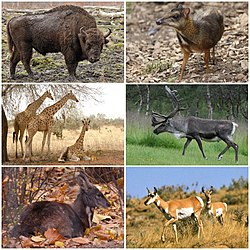^ a b c Waddell, P. J.; Okada, N.; Hasegawa, M. (1999). “Towards resolving the interordinal relationships of placental mammals”. Systematic Biology 48 (1): 1–5. doi :10.1093/sysbio/48.1.1 . JSTOR 2585262 . PMID 12078634 .
^ a b Spaulding, M.; O'Leary, M.A.; Gatesy, J. (2009). “Relationships of Cetacea (Artiodactyla) Among Mammals: Increased Taxon Sampling Alters Interpretations of Key Fossils and Character Evolution”. PLoS ONE 4 (9): e7062. https://doi.org/10.1371/journal.pone.0007062 .
^ Robin M.D. Beck, Olaf R.P. Bininda-Emonds, Marcel Cardillo, Fu-Guo Robert Liu & Andy Purvis (2006). “A higher-level MRP supertree of placental mammals” . BMC Ecology and Evolution 6 : 93. doi :10.1186/1471-2148-6-93 . PMC 1654192 . PMID 17101039 . https://www.ncbi.nlm.nih.gov/pmc/articles/PMC1654192/ . ^ O'Leary, M.A.; Bloch, J.I.; Flynn, J.J.; Gaudin, T.J.; Giallombardo, A.; Giannini, N.P. et al. (2013). “The placental mammal ancestor and the post-K-Pg radiation of placentals”. Science 339 (6120): 662–667. doi :10.1126/science.1229237 . hdl :11336/7302 PMID 23393258 . ^ Song, S.; Liu, L.; Edwards, S.V.; Wu, S. (2012). “Resolving conflict in eutherian mammal phylogeny using phylogenomics and the multispecies coalescent model” . Proceedings of the National Academy of Sciences 109 (37): 14942–14947. doi :10.1073/pnas.1211733109 . PMC 3443116 . PMID 22930817 . https://www.ncbi.nlm.nih.gov/pmc/articles/PMC3443116/ . ^ dos Reis, M.; Inoue, J.; Hasegawa, M.; Asher, R.J.; Donoghue, P.C.J.; Yang, Z. (2012). “Phylogenomic datasets provide both precision and accuracy in estimating the timescale of placental mammal phylogeny” . Proceedings of the Royal Society B: Biological Sciences 279 (1742): 3491–3500. doi :10.1098/rspb.2012.0683 . PMC 3396900 . PMID 22628470 . https://www.ncbi.nlm.nih.gov/pmc/articles/PMC3396900/ . ^ Upham, N.S.; Esselstyn, J.A.; Jetz, W. (2019). “Inferring the mammal tree: Species-level sets of phylogenies for questions in ecology, evolution, and conservation” . PLoS Biology 17 (12): e3000494. doi :10.1371/journal.pbio.3000494 . PMC 6892540 . PMID 31800571 . https://www.ncbi.nlm.nih.gov/pmc/articles/PMC6892540/ ;

